Survivor, Daughter Cover Globe With Collections
Two Silvas are better than one in a Buckhead condominium building.
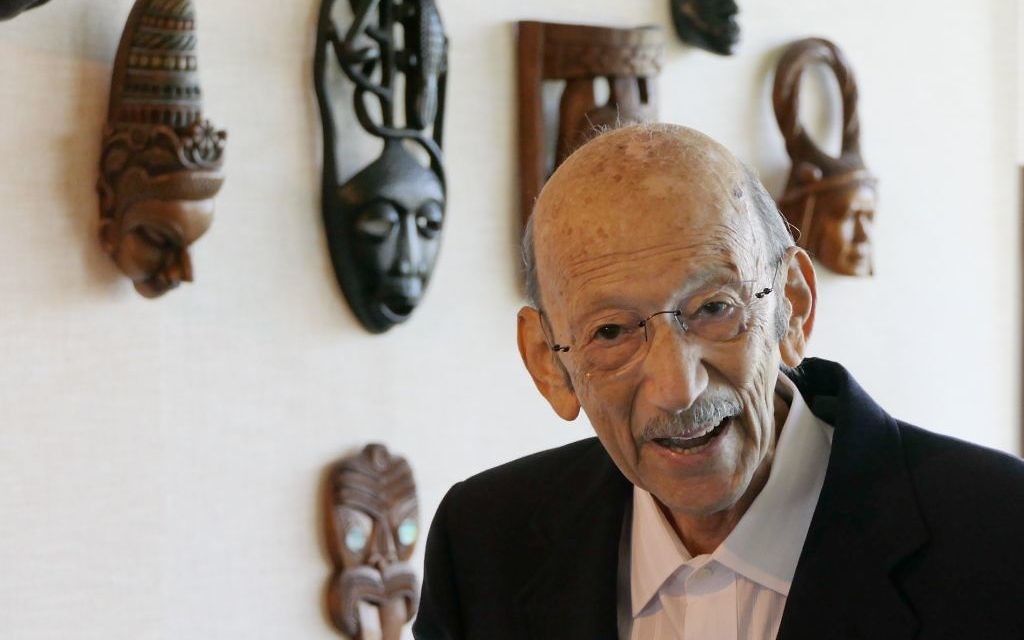
Two collectors are better than one. John Silva, nee Hans Rolf, and daughter Sharon live only floors apart in a Buckhead condominium building. John goes for clean German lines, while Sharon dramatizes with black walls and an Asian theme.
Jaffe: It’s convenient that you and Dad live in the same building. How does that work? Have you artistically influenced each other?
Sharon: After years in Sandy Springs and turning 50, I was ready for a change. After my mother passed away, living in the same building as my father allowed me to spend daily time with him. Today, at 95, it has come in very handy.
Get The AJT Newsletter by email and never miss our top stories Free Sign Up
We share similar floor plans but on different floors and with a very different aesthetic. He favors European, modern lines, and I am drawn to Chinese Chippendale. I lean toward Asian, tempered with English and other things that catch my eye. I recently bought a unique metal chair sculpture from 14th Street Antiques & Modern Home.
Jaffe: How did you end up in the U.S.?
John: At 17, I fled Germany alone shortly after Kristallnacht (1938), boarding an Italian steamer headed to South America, with nothing more than a prized stamp collection. There I suffered through malaria and yellow fever while working in the Bolivian jungle, clearing brush with machetes. Under the auspices of the International Red Cross, this program was a source of subsistence employment for many young refugees.
Desperate to flee the hardship of the jungle, feigning a toothache, I sought out a dentist in the capital city, La Paz. After menial jobs and savvy card playing, I reached Argentina (in the trunk of an official’s car) and went on to Montevideo, Uruguay. There a kind Frenchman taught me the wool trade. I met my wife, the only child of refugees who fled Germany via the Trans-Siberian Railway to Montevideo, and married in 1944.
In 1947, in a brief window of opportunity for refugees to immigrate to the U.S. under a program designed to help orphaned children of the Holocaust, I found a sponsor from a contact made trading stamps. From New York City, I ran my wool business brokering raw materials from farms in South America, Australia and New Zealand and selling to carpet mills in the Northeast.
In 1986 we moved to Atlanta to live near Sharon.
Jaffe: How would you describe your style here?
Sharon: I am definitely drawn to Asian furniture and accents. Chinese Chippendale is a good description, as I have ball and claw-foot and English pieces mixed with the Asian aesthetic. Incidentally, Mandarin Antiques on Cheshire Bridge Road is the foremost Chinese antiques importer in the Southeast.
I am partial to trees. The view from my living room and dining room faces northwest, and I am in a tree canopy.
Jaffe: Your black walls are very dramatic. What are you accomplishing with them? Did you use a designer?
Sharon: No designer. I’ve always heard that you should paint your walls a color that you enjoy. Ninety-five percent of my wardrobe is black, and I wanted to feature the paintings, so, with floor-to-ceiling windows, I went with my gut instinct, painting the foyer, gallery and living room black. At night it is quite dramatic. Track lighting emphasizes the paintings, and they truly pop. I’ve never had a single regret.
Jaffe: What interests you about cloisonné? Any stories about how you acquired some of the pieces?
Sharon: My first introduction to cloisonné was in 1977. While I was living in the Philippines, I visited Hong Kong and purchased it to bring home as gifts. Once back in the U.S., I lamented that I did not purchase any for myself. Since then, I search flea markets, estate sales and antique stores and, little by little, acquire pieces. I am drawn to color, detail and condition. Cloisonné is an intricate, eight-step process. Designs are created on metal objects (vases, ginger jars, plates, bowls) with colored glass paste filling design enclosures made by hand out of copper or bronze wires, bent or hammered into the desired pattern.
My mother’s ashes are in a beautiful cloisonné butterfly jar. Whenever a butterfly circles near me, I feel she is visiting.
Jaffe: Tell us about your mask and ivory collections.
John: Many ages and types of wood. The African masks are more valuable than the South American ones. The most unusual is whalebone. The ivory, illegal now, was purchased around 1955. Some have scrimshaw carvings done by sailors.
Jaffe: You collect M. Stuart and Ford Smith. What about them appeals to you, and how did you discover them?
Sharon: The paintings I gravitate toward have a similar aesthetic. Michael Stuart Maguire was a featured artist at Opus One Gallery on Bennett Street and later at Taylor Kinzel Gallery in Roswell. I first saw his work (“Red Tree”) in 2003. This was my first significant art purchase. His work also hangs in the Federal Reserve of Atlanta. He is one of my favorite artists, and I have eight of his paintings.
Ford Smith, whose eponymous gallery is in Roswell, is another favorite. I also met Ford in 2002 at Gallery SKLO on Bennett Street. I currently have three of his paintings. Two very large pieces of his work hang at Hennessy Lexus.
I’m always surprised that while I don’t purposefully search for trees, the paintings I’m drawn to feature them. My most recent purchase, Ford Smith’s “Twilight Tango,” humanizes two trees and is quite compelling.
Jaffe: Are you done collecting?
Sharon: There comes a point when everything is in its place. I could say that I am done collecting, but I know better: Never say never. When something speaks to me, I listen. If a piece stops you in your tracks, there is a reason. Life has its challenges; when you come home, be surrounded by art you enjoy.
I would love to own works by Frank Sinatra and Tony Bennett. Later in their careers, they painted to relax. Those would be special.
Photos by Duane Stork
-
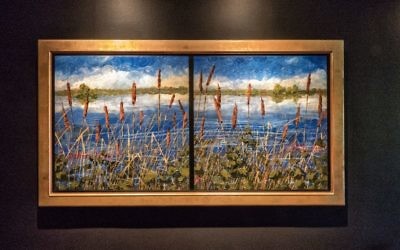
- M. Stuart’s “Cattails” duo painting hangs on the dramatic black walls Sharon Silva created with Porter Paints’ Black Onyx, Smoky Olive and Green Gray Mist colors.
-
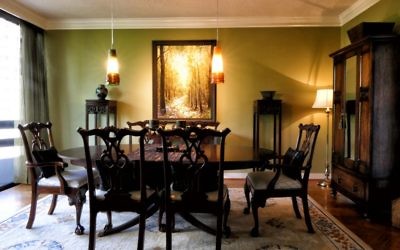
- Sharon Silva’s dining room uses fixtures from Yaakov Golan’s Lighting Loft to frame M. Stuart’s “Through the Trees.”
-
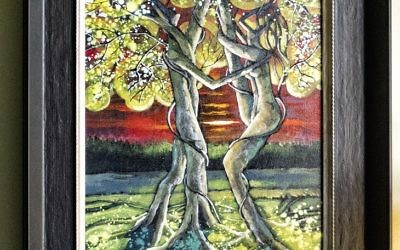
- Sharon Silva says she is attracted to art featuring trees and nature, such as “Twilight Tango” by Ford Smith.
-
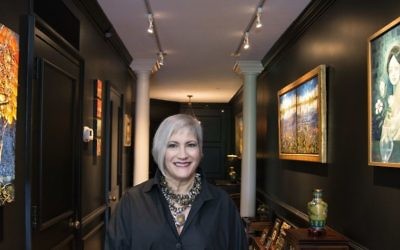
- Sharon Silva’s entrance art gallery includes “Lunar Ambition” (left) by Ford Smith and “Blue Lady 1953” (right) by Angel Oblitas.
-
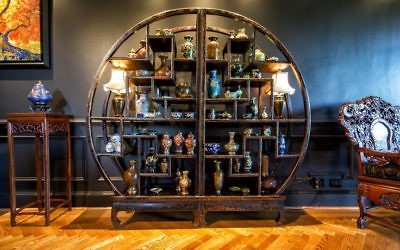
- A 6-foot-wide, crackled-wood, Mandarin-style shelf houses Sharon Silva’s collection of cloisonné. The wood floor features an unusual herringbone pattern.
-
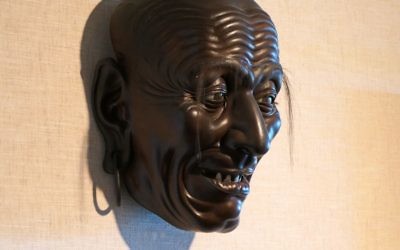
- John Silva, who speaks four languages, says his African masks are more collectible than those he acquired from South America.




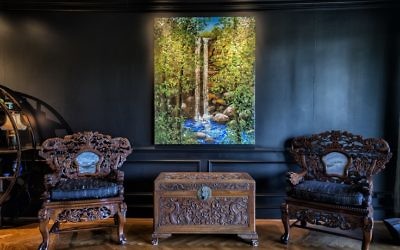
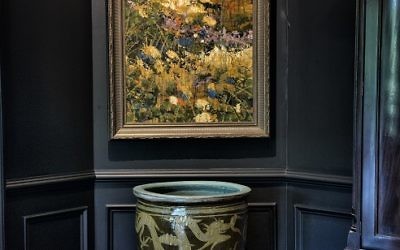
comments